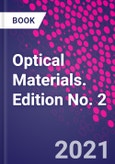Optical Materials, Second Edition, presents, in a unified form, the underlying physical and structural processes that determine the optical behavior of materials. It does this by combining elements from physics, optics, and materials science in a seamless manner, and introducing quantum mechanics when needed. The book groups the characteristics of optical materials into classes with similar behavior. In treating each type of material, the text pays particular attention to atomic composition and chemical makeup, electronic states and band structure, and physical microstructure so that the reader will gain insight into the kinds of materials engineering and processing conditions that are required to produce a material exhibiting a desired optical property. The physical principles are presented on many levels, including a physical explanation, followed by formal mathematical support and examples and methods of measurement. The reader may overlook the equations with no loss of comprehension, or may use the text to find appropriate equations for calculations of optical properties.
Please Note: This is an On Demand product, delivery may take up to 11 working days after payment has been received.
Table of Contents
1. Wave Propagation2. Optical Properties of Conductors3. Optical Properties of Insulators Fundamentals4. Optical Properties of Insulators Materials, Devices, and Applications5. Optical Properties of Semiconductors6. Energy-Related Optical Materials7. Optical Gain and Lasers8. Nonlinear Optical processes in Materials
Authors
Kelly S. Potter University of Arizona, Tucson, Arizona - USA. Kelly S. Potter is a Professor and Director of Graduate Studies of Electrical and Computer Engineering, Professor of Optical Sciences, Professor of Materials Science and Engineering, and Professor of the Indigenous Food, Energy and Water Systems Graduate Interdisciplinary Program at the University of Arizona in Tucson, AZ. Dr. Potter received her B.S. in Physics in 1986 from Florida State University and her M.S. and Ph.D. in 1990 and 1994 respectively in Optical Sciences from the University of Arizona. In addition, she served as a research associate at the Massachusetts Institute of Technology, the Universit� de Rennes (France), and the Naval Research Laboratories between 1985 and 1990. Dr. Potter spent nearly 10 years at Sandia National Laboratories, from 1994 to 2003, ending in the position of Principal Member of Technical Staff and Project Manager for Advanced Optical Technologies. In 2003 she left Sandia National Laboratories to return to academia at the University of Arizona.Dr. Potter is a Fellow of the American Ceramic Society (ACerS), Director of the Arizona Research Initiative for Solar Energy (AzRISE), and is the current Vice-Chair of the Hardened Electronics and Radiation Technology (HEART) Society. She served on the Executive Committee of the Glass and Optical Materials Division of ACerS between 2009 and 2013, on the Steering Committee of the HEART Society from 2009-2012 and again from 2015-2024, as executive editor of the Journal of Radiation Effects Research and Engineering (JRERE) from 2015 to 2018, and has served on the Editorial Advisory Board of the Journal of Non-Crystalline Solids since 2011. She is the co-author of three textbooks in the field of optics, has authored more than 100 peer-reviewed publications, has delivered over 150 scholarly presentations to international audiences, and holds several patents. Her research, for which she has received a number of awards, focuses on radiation-hardened optics, photosensitive materials and devices, and sustainable energy systems. Joseph H. Simmons University of Arizona, ret., Tucson, Arizona - USA. Retired Eminent Professor and Baucke Chair at the Florida Gulf Coast University (Fort Myers, FL) where he was the Founding Director of the Emergent Technologies Institute for 5 years, which culminated in the building of the off-campus ETI teaching and research facility and a solar field installation. Simmons retired from the University of Arizona in 2013 after serving as Head of the Materials Science and Engineering Department since 2000. During that time, in addition to conducting research into quantum confinement and ultrafast optical processes in semiconductors, Simmons investigated new photovoltaic materials and a variety of energy storage technologies. Under the direction of Simmons, the Department of Materials Science and Engineering started unique degree-granting programs in optical materials science, computational materials research, and heritage conservation science. Simmons joined the University of Arizona as Department Head, after serving 16 years as Professor in the Department of Materials Science & Engineering and an Affiliate Professor in the Department of Physics at the University of Florida. His prior posts were in the Physics Department of the Catholic University of America (10 years), the National Bureau of Standards (currently NIST) (8 years) and the National Aeronautics and Space Administration (4 years).
Joseph Simmons graduated with a BS (University of Maryland), an MS (John Carroll University) and a PhD (Catholic University) in Physics. His studies have spanned numerous topics in condensed matter physics, optical physics and computational materials modeling and have included: (1) fundamental studies of quantum-size effects on excitons in nanoclusters, (2) time-resolved measurements of optical properties and carrier dynamics in wide bandgap semiconductors, (3) investigations of the processes underlying linear and non-linear optical behavior in inorganic glasses, including electronic Kerr non-linearity and permanent and transient photosensitivity of glass films, (4) atomistic simulations of optical and mechanical properties of various solids, and (5) non-linear viscous flow and rheological behavior of molten glasses. Simmons is the author of over 150 peer-reviewed journal articles, 16 US patents, 4 book chapters and the editor of 2 books. Simmons was the Editor of the Journal of Non-Crystalline Solids for over 10 years.








